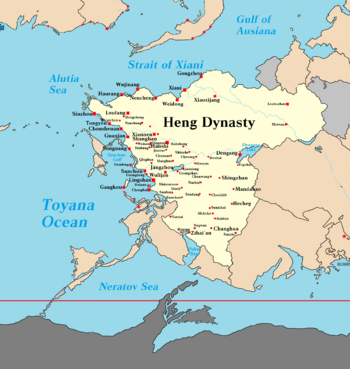Heng Dynasty
Great Heng Dà Heng | |
|---|---|
| 1630–1908 | |
 Land controlled by the Heng dynasty in 1790. | |
| Capital | Guanjan (1636–1844) Shanghan (1844–1908) |
| Largest city | Shanghan |
| Official languages | Mandarin, Panchu, numerous regional languages and varieties of Yuaneze |
| Government | Absolute monarchy |
| Emperor | |
• 1630–1649 | Heng Liao (founder) |
• 1841–1889 | Shanzha Emperor (first in Shanghan) |
• 1889-1908 | Guanting Emperor (last) |
| Legislature | None (rule by decree) |
| Historical era | Late modern |
• Established | 1630 |
| May 6th 1908 | |
The Heng Dynasty was the last dynasty in the imperial history of Yuan. It was established in 1630, and ruled Yuan proper from 1634 to 1908. At its peak of power, it ruled over most of West Ausiana in territories including present-day Pangchu, Mandrao, Gangkou, Barangadesh, and Tosichi. The multiethnic Heng empire lasted for almost three centuries and assembled the territorial base for modern Yuan. With a population of 300 million around 1900, it was the most populous country in the world at the time.
The Heng Dynasty came to power in 1630 after the deposition of the Lim Dynasty. Its conquests of neighboring territories killed millions of people. In the mid 18th century, imperialism from Adulan nations began to reach west Ausiana and Yuan's emperors began opening up to interventionists and foreign involvement. In 1900, the Yellow Flag Rebellion erupted when socialist, anti-imperialist revolutionaries began a campaign to overthrow the emperor and expel foreign powers from Yuan. In 1906, largely as a result of the violence from the Yellow Flag Rebellion, the great Yuaneze diaspora began. Losses due to emigration were added to by conflicts and catastrophes such as the Southern Yuan Famine of 1904-1910, in which between 9 and 13 million people died. Emperor Pan Guanting drafted a reform plan in 1908 to establish a modern constitutional monarchy, but in the 1908 Yuan Revolution, socialists assassinated Guanting, ended the Heng Dynasty, and established a socialist, one-party republic.
History
In 1630, the Heng Dynasty came to power following a deposition of the Lim Dynasty. Emperors conquered regions spanning to modern day Barangadesh, which expanded the Yuaneze culture beyond ancient trade routes to established presence. The Heng dynasty, which lasted from 1630 until 1908, was the last imperial dynasty of Yuan. In conquest of its southernmost regions, specifically Tosichi, millions died and the economy of the empire began to dramatically collapse. The centralized autocracy was strengthened to suppress anti-Heng sentiment with the policy of valuing agriculture and restraining commerce and ideological control as represented by the literary inquisition, causing social and technological stagnation.
In the mid 18th century, Yuan began to feel the effects of imperialism from nations like Skith and Quetana, opening up to interventionists. The emperors and their courts bended to foreign involvement, especially as the 19th century rolled around and major powers emerged like Zamastan and Avergnon who sought to spread their economic growth internationally. Multiple cities of influence were founded by Adulan powers, most notably Quetana, Vitosium, and Timeria, who established sectors of commerce within cities like Xiani, Sancheon, Shanghan, and Guanjan.
In 1900, the Yellow Flag Rebellion erupted when socialist, anti-imperialist revolutionaries began a campaign to overthrow the emperor and expel foreign powers from Yuan. The Battle of Guangadou on September 4th, 1902, brought greater foreign intervention to the nation, with Zamastan, Caspiaa, and Drambenburgian interests backing the emperor and his government. On August 6th, 1905, the Treaty of Tiaking ended the Yellow Flag Rebellion, and the emperor granted the island of Gangkou to Zamastan in a deal of a 2-century lease.

In 1906, largely as a result of the violence from the Yellow Flag Rebellion, the great Yuaneze diaspora began. Losses due to emigration were added to by conflicts and catastrophes such as the Southern Yuan Famine of 1904-1910, in which between 9 and 13 million people died. Emperor Pan Guanting drafted a reform plan in 1908 to establish a modern constitutional monarchy, but in the 1908 Yuan Revolution, socialists assassinated Guanting, ended the Heng Dynasty, and established a socialist, one-party republic.